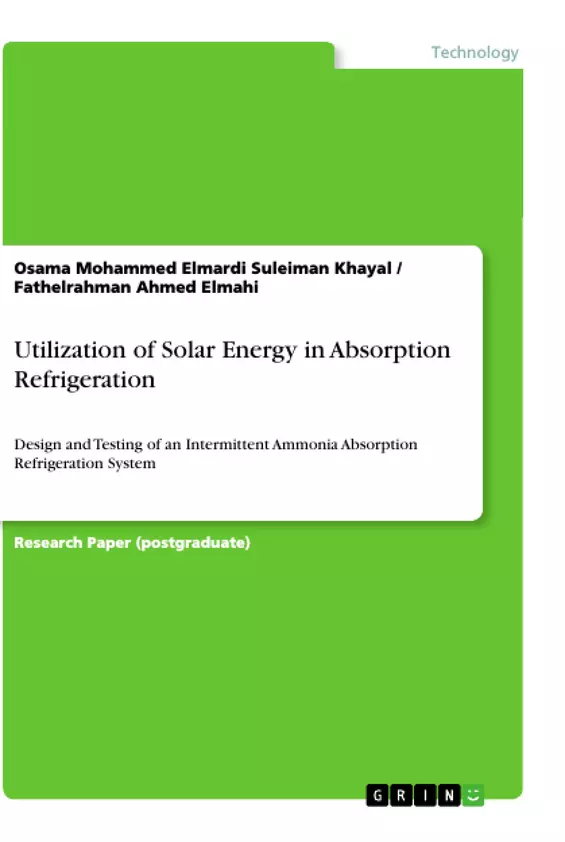Solar energy can be utilized by, either, thermal conversion, or electrical conversion, of solar radiation. Utilization of solar energy by thermal conversion method, is of low cost, but it requires high density of solar radiation. Electrical conversion method, on the other hand, is expensive, but it does not need high density of solar radiation. One of the most important applications of thermal conversion of solar energy, is absorption refrigeration. As there are many factors affecting the process of solar refrigeration, a lot of research work must be carried out, before deciding an optimum design of solar refrigeration systems, which utilize solar energy at a low cost. The main objective of this research article is to design and construct an apparatus which can be used, as a test rig, by research students, to carry out experiments, regarding the performance of solar absorption refrigeration systems. The apparatus has been designed and constructed so as to be used indoors. One of the many different factors which affect the performance of solar absorption refrigeration systems, has been chosen, to test the apparatus, for functioning. This is the effect of condenser temperature, on the performance of solar absorption refrigeration systems. The apparatus has been tested for three different values of condenser temperature, and yielded very good results. The experimental work proves that, the coefficient of performance of a solar absorption refrigeration system, is high, at a low condenser temperature. At a condenser temperature of about 25ºC, the actual coefficient of performance, obtained is 0.019, compared with a theoretical value of 0.062. And at a condenser temperature of about 15ºC, the actual coefficient of performance is 0.026, compared with a theoretical value of 0.094.
Inhaltsverzeichnis (Table of Contents)
- I. INTRODUCTION
- II. LITERATURE REVIEW
- 1. Solar energy
- 2. Refrigeration
- Vapor Compression Cycle
- Absorption Refrigeration
Zielsetzung und Themenschwerpunkte (Objectives and Key Themes)
This research aims to design and construct an apparatus for testing the performance of solar absorption refrigeration systems. The objective is to provide research students with a practical tool for conducting experiments on this important renewable energy technology. The study also investigates the impact of condenser temperature on system performance.
- Solar energy utilization in absorption refrigeration
- Design and construction of an experimental test rig
- Impact of condenser temperature on system performance
- Comparison of experimental results with theoretical predictions
- Mathematical modeling and computer simulation of absorption refrigeration systems
Zusammenfassung der Kapitel (Chapter Summaries)
- I. INTRODUCTION: This chapter provides a broad overview of energy challenges facing developing countries and emphasizes the need for alternative energy sources, particularly solar energy. It discusses the advantages of solar energy, its potential applications, and the importance of efficient utilization through thermal conversion methods, specifically absorption refrigeration.
- II. LITERATURE REVIEW: This chapter offers a comprehensive review of relevant literature on solar energy and refrigeration. It delves into the fundamental principles of both topics, providing details on various types of solar collectors, refrigeration cycles, and their respective components. It also highlights the advantages and limitations of vapor compression and absorption refrigeration systems.
Schlüsselwörter (Keywords)
The primary focus of this research is on the design, construction, and experimental investigation of solar absorption refrigeration systems. Key areas of exploration include: solar energy utilization, thermal conversion, absorption refrigeration, condenser temperature, system performance, mathematical modeling, computer simulation, and experimental validation.
- Arbeit zitieren
- Associate Professor Osama Mohammed Elmardi Suleiman Khayal (Autor:in), Dr. Fathelrahman Ahmed Elmahi (Autor:in), 2004, Utilization of Solar Energy in Absorption Refrigeration, München, GRIN Verlag, https://www.grin.com/document/540530



